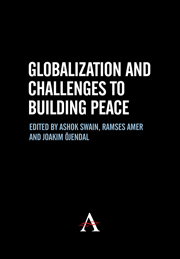Book contents
- Frontmatter
- Contents
- Acknowledgements
- List of Contributors
- 1 Building Peace in the Era of Three Waves
- 2 The Problem of Peace: Understanding the ‘Liberal Peace’
- 3 Pre-emptive Self-defence New Legal Principle or Political Action?
- 4 Beyond Criminal Justice: Promoting the Rule of Law in Post-Conflict Societies
- 5 Peace by Pact: Data on the Implementation of Peace Agreements
- 6 Refugee Repatriation as a Necessary Condition for Peace
- 7 Catapulting Conflicts or Propelling Peace: Diasporas and Civil Wars
- 8 UN Peace Operations as Norm Entrepreneurs: The Challenge of Achieving Communicative Action on Human Rights
- 9 To Practice What They Preach: International Transitional Administrations and the Paradox of Norm Promotion
- 10 Re-examining the Roots of War in West Africa in a Globalizing World
- 11 The African Union (AU) and Its Commitment to Non-Indifference: Can the AU be an Actor for the Promotion of Human Security?
- 12 Hamas Between Sharia Rule and Demo-Islam
- 13 Environmental Scarcity and Intrastate Conflicts: The Case of Nepal
- 14 Narcotics: The New Security Threat for China
- References
- Bibliography
6 - Refugee Repatriation as a Necessary Condition for Peace
Published online by Cambridge University Press: 05 March 2012
- Frontmatter
- Contents
- Acknowledgements
- List of Contributors
- 1 Building Peace in the Era of Three Waves
- 2 The Problem of Peace: Understanding the ‘Liberal Peace’
- 3 Pre-emptive Self-defence New Legal Principle or Political Action?
- 4 Beyond Criminal Justice: Promoting the Rule of Law in Post-Conflict Societies
- 5 Peace by Pact: Data on the Implementation of Peace Agreements
- 6 Refugee Repatriation as a Necessary Condition for Peace
- 7 Catapulting Conflicts or Propelling Peace: Diasporas and Civil Wars
- 8 UN Peace Operations as Norm Entrepreneurs: The Challenge of Achieving Communicative Action on Human Rights
- 9 To Practice What They Preach: International Transitional Administrations and the Paradox of Norm Promotion
- 10 Re-examining the Roots of War in West Africa in a Globalizing World
- 11 The African Union (AU) and Its Commitment to Non-Indifference: Can the AU be an Actor for the Promotion of Human Security?
- 12 Hamas Between Sharia Rule and Demo-Islam
- 13 Environmental Scarcity and Intrastate Conflicts: The Case of Nepal
- 14 Narcotics: The New Security Threat for China
- References
- Bibliography
Summary
The conventional wisdom of most refugee experts holds that there is a necessary connection between forging and implementing a peace agreement and ensuring the successful return of refugees. Peace depends on refugee repatriation, and every peace agreement must provide for it, or so it is widely believed.
Howard AdelmanIntroduction
There are around 12 million refugees around the world today. The total population of concern to the United Nations High Commissioner for Refugees (UNHCR), including asylum seekers, internally displaced persons (IDPs) and stateless persons, is nearly 20 million, many of whom are displaced as a result of armed conflict (US Committee for Refugees 2006; UNHCR 2006). There are three types of durable solutions to refugee situations: return/repatriation, local integration and resettlement in a third country. Repatriation has over the past twenty years become the distinctively most important solution, preferred by the UNHCR as well as most host states. Having long been the ideal solution only in theory, in the mid-1980s repatriation started to be endorsed as the ideal solution also in practice, and today the other two solutions – local integration and resettlement – are applicable to less than 1 per cent of the world's refugees (Chimni, 2003, p. 195; 2004).
In an Agenda for Peace, under the heading ‘Post-conflict peace-building’, Boutros-Ghali (1992, Para 55) included refugee repatriation among factors that will help to consolidate peace after war. In 1997, then High Commissioner Ogata (1997, p. vii) wrote that ‘peace-building requires just solutions for refugees and displaced persons.
- Type
- Chapter
- Information
- Globalization and Challenges to Building Peace , pp. 91 - 106Publisher: Anthem PressPrint publication year: 2007

